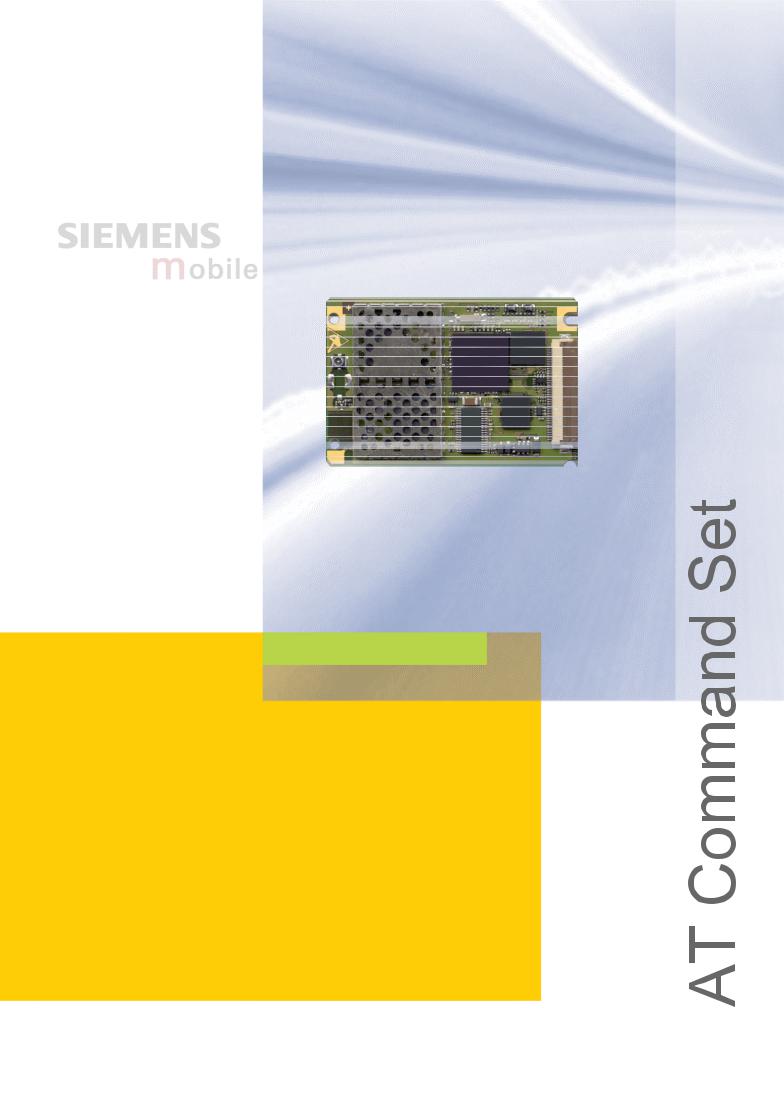Siemens MC39i User Manual

MC39i
Siemens Cellular Engine
Version: 01.02
DocID: MC39i_ATC_V01.02

MC39i AT Command Set
Confidential / Released
s
mobile
Document Name: |
MC39i AT Command Set |
Version: |
01.02 |
Date: |
November 11, 2003 |
DocId: |
MC39i_ATC_V01.02 |
Status: |
Confidential / Released |
|
|
General Notes
Product is deemed accepted by recipient and is provided without interface to recipient’s products. The documentation and/or product are provided for testing, evaluation, integration and information purposes. The documentation and/or product are provided on an “as is” basis only and may contain deficiencies or inadequacies. The documentation and/or product are provided without warranty of any kind, express or implied. To the maximum extent permitted by applicable law, Siemens further disclaims all warranties, including without limitation any implied warranties of merchantability, completeness, fitness for a particular purpose and non-infringement of third-party rights. The entire risk arising out of the use or performance of the product and documentation remains with recipient. This product is not intended for use in life support appliances, devices or systems where a malfunction of the product can reasonably be expected to result in personal injury. Applications incorporating the described product must be designed to be in accordance with the technical specifications provided in these guidelines. Failure to comply with any of the required procedures can result in malfunctions or serious discrepancies in results. Furthermore, all safety instructions regarding the use of mobile technical systems, including GSM products, which also apply to cellular phones must be followed. Siemens or its suppliers shall, regardless of any legal theory upon which the claim is based, not be liable for any consequential, incidental, direct, indirect, punitive or other damages whatsoever (including, without limitation, damages for loss of business profits, business interruption, loss of business information or data, or other pecuniary loss) arising out the use of or inability to use the documentation and/or product, even if Siemens has been advised of the possibility of such damages. The foregoing limitations of liability shall not apply in case of mandatory liability, e.g. under the German Product Liability Act, in case of intent, gross negligence, injury of life, body or health, or breach of a condition which goes to the root of the contract. However, claims for damages arising from a breach of a condition, which goes to the root of the contract, shall be limited to the foreseeable damage, which is intrinsic to the contract, unless caused by intent or gross negligence or based on liability for injury of life, body or health. The above provision does not imply a change on the burden of proof to the detriment of the recipient. Subject to change without notice at any time. The interpretation of this general note shall be governed and construed according to German law without reference to any other substantive law.
Copyright
Transmittal, reproduction, dissemination and/or editing of this document as well as utilization of its contents and communication thereof to others without express authorization are prohibited. Offenders will be held liable for payment of damages. All rights created by patent grant or registration of a utility model or design patent are reserved.
Copyright © Siemens AG 2003
MC39i_ATC_V01.02 |
Page 2 of 314 |
11.11.2003 |

MC39i AT Command Set
Confidential / Released
s
mobile
Contents |
|
|
||
1 |
Introduction................................................................................................... |
9 |
||
1.1 |
Scope of the document ............................................................................................................. |
9 |
||
1.2 |
Related documents ................................................................................................................... |
9 |
||
1.3 |
Conventions and abbreviations............................................................................................... |
10 |
||
1.4 |
AT command syntax ............................................................................................................... |
10 |
||
1.4.1 |
Using parameters.................................................................................................................... |
10 |
||
1.4.2 |
Combining AT commands on the same command line .......................................................... |
11 |
||
1.4.3 |
Entering successive AT commands on separate lines ........................................................... |
11 |
||
1.4.4 |
Communication between customer application and MC39i.................................................... |
11 |
||
1.4.5 |
Unsolicited Result Codes (URCs)........................................................................................... |
12 |
||
1.5 |
Supported character sets ........................................................................................................ |
13 |
||
1.5.1 |
UCS2 and GSM data coding and conversion in SMS text mode and Remote-SAT............... |
14 |
||
1.6 |
Flow control............................................................................................................................. |
17 |
||
1.6.1 |
Software flow control (XON/OFF flow control) ........................................................................ |
17 |
||
1.6.2 |
Hardware flow control (RTS/CTS flow control) ....................................................................... |
17 |
||
2 |
Standard V.25ter AT Commands ............................................................... |
18 |
||
2.1 |
A/ Repeat previous command line ......................................................................................... |
18 |
||
2.2 |
+++ Switch from data mode or PPP online mode to command mode................................... |
18 |
||
2.3 |
AT\Qn |
Flow control ................................................................................................................ |
19 |
|
2.4 |
ATA Answer a call.................................................................................................................. |
20 |
||
2.5 |
ATD |
Mobile originated call to dial a number .......................................................................... |
21 |
|
2.6 |
ATD><mem><n> Originate call to phone number <n> in memory <mem> .......................... |
24 |
||
2.7 |
ATD><n> Originate call to phone number selected from active memory.............................. |
26 |
||
2.8 |
ATD><str> Originate call to phone number in memory with corresponding field .................. |
27 |
||
2.9 |
ATDI Mobile originated call to dialable ISDN number <n> .................................................... |
28 |
||
2.10 |
ATDL Redial last telephone number used ............................................................................. |
29 |
||
2.11 |
ATE Enable command echo .................................................................................................. |
30 |
||
2.12 |
ATH |
Disconnect existing connection ..................................................................................... |
30 |
|
2.13 |
ATI |
Display product identification information........................................................................ |
31 |
|
2.14 |
ATI[value] Display additional identification information.......................................................... |
31 |
||
2.15 |
ATL Set monitor speaker loudness........................................................................................ |
32 |
||
2.16 |
ATM Set monitor speaker mode ............................................................................................ |
32 |
||
2.17 |
ATO Switch from command mode to data mode / PPP online mode.................................... |
32 |
||
2.18 |
ATQ |
Set result code presentation mode................................................................................ |
33 |
|
2.19 |
ATP |
Select pulse dialing ........................................................................................................ |
33 |
|
2.20 |
ATS0 |
Set number of rings before automatically answering the call ...................................... |
33 |
|
2.21 |
ATS3 Write command line termination character .................................................................. |
34 |
||
2.22 |
ATS4 |
Set response formatting character............................................................................... |
34 |
|
2.23 |
ATS5 Write command line editing character.......................................................................... |
34 |
||
2.24 |
ATS6 |
Set pause before blind dialing...................................................................................... |
35 |
|
2.25 |
ATS7 |
Set number of seconds to wait for connection completion .......................................... |
35 |
|
2.26 |
ATS8 Set number of seconds to wait for comma dial modifier.............................................. |
35 |
||
2.27 |
ATS10 |
Set disconnect delay after indicating the absence of data carrier ............................. |
36 |
|
2.28 |
ATS18 |
Extended error report................................................................................................. |
37 |
|
2.29 |
ATT |
Select tone dialing.......................................................................................................... |
38 |
|
2.30 |
ATV Set result code format mode.......................................................................................... |
39 |
||
2.31 |
ATX Set CONNECT result code format and call monitoring.................................................. |
39 |
||
2.32 |
ATZ |
Set all current parameters to user defined profile .......................................................... |
40 |
|
2.33 |
AT&C |
Set circuit Data Carrier Detect (DCD) function mode.................................................. |
40 |
|
2.34 |
AT&D Set circuit Data Terminal Ready (DTR) function mode............................................... |
41 |
||
2.35 |
AT&F |
Set all current parameters to manufacturer defaults ................................................... |
42 |
|
2.36 |
AT&S |
Set circuit Data Set Ready (DSR) function mode........................................................ |
44 |
|
2.37 |
AT&V |
Display current configuration ....................................................................................... |
45 |
|
MC39i_ATC_V01.02 |
Page 3 of 314 |
11.11.2003 |

MC39i AT Command Set
Confidential / Released
s
mobile
2.38 |
AT&W Store current configuration to user defined profile ..................................................... |
47 |
|
2.39 |
AT+GCAP |
Request complete TA capabilities list .................................................................. |
49 |
2.40 |
AT+GMI Request manufacturer identification........................................................................ |
49 |
|
2.41 |
AT+GMM Request TA model identification............................................................................ |
49 |
|
2.42 |
AT+GMR |
Request TA revision identification of software status ............................................ |
50 |
2.43 |
AT+GSN Request TA serial number identification (IMEI)...................................................... |
50 |
|
2.44 |
AT+ILRR Set TE-TA local rate reporting ................................................................................ |
51 |
|
2.45 |
AT+IPR Set fixed local rate..................................................................................................... |
52 |
|
2.45.1 |
Autobauding ............................................................................................................................ |
53 |
|
3 |
AT Commands for FAX............................................................................... |
54 |
|
3.1 |
AT+FBADLIN Bad Line Threshold......................................................................................... |
55 |
|
3.2 |
AT+FBADMUL Error Threshold Multiplier.............................................................................. |
55 |
|
3.3 |
AT+FBOR Query data bit order ............................................................................................. |
56 |
|
3.4 |
AT+FCIG |
Query or set the Local polling id ............................................................................ |
57 |
3.5 |
AT+FCLASS Fax: Select, read or test service class ............................................................. |
58 |
|
3.6 |
AT+FCQ Copy Quality Checking ........................................................................................... |
59 |
|
3.7 |
AT+FCR Capability to receive................................................................................................ |
59 |
|
3.8 |
AT+FDCC Query or set capabilities....................................................................................... |
60 |
|
3.9 |
AT+FDFFC Data Compression Format Conversion.............................................................. |
61 |
|
3.10 |
AT+FDIS Query or set session parameters........................................................................... |
62 |
|
3.11 |
AT+FDR Begin or continue phase C data reception.............................................................. |
63 |
|
3.12 |
AT+FDT Data Transmission .................................................................................................. |
63 |
|
3.13 |
AT+FET End a page or document ......................................................................................... |
64 |
|
3.14 |
AT+FK Kill operation, orderly FAX abort................................................................................ |
64 |
|
3.15 |
AT+FLID Query or set the Local Id setting capabilities ......................................................... |
64 |
|
3.16 |
AT+FMDL Identify Product Model.......................................................................................... |
65 |
|
3.17 |
AT+FMFR |
Request Manufacturer Identification .................................................................... |
65 |
3.18 |
AT+FOPT |
Set bit order independently................................................................................... |
65 |
3.19 |
AT+FPHCTO DTE Phase C Response Timeout ................................................................... |
66 |
|
3.20 |
AT+FREV |
Identify Product Revision...................................................................................... |
66 |
3.21 |
AT+FRH Receive Data Using HDLC Framing ....................................................................... |
66 |
|
3.22 |
AT+FRM Receive Data .......................................................................................................... |
67 |
|
3.23 |
AT+FRS Receive Silence ...................................................................................................... |
67 |
|
3.24 |
AT+FTH Transmit Data Using HDLC Framing ...................................................................... |
67 |
|
3.25 |
AT+FTM Transmit Data ......................................................................................................... |
68 |
|
3.26 |
AT+FTS Stop Transmission and Wait ................................................................................... |
68 |
|
3.27 |
AT+FVRFC Vertical resolution format conversion ................................................................. |
69 |
|
4 |
AT Commands originating from GSM 07.07 ............................................. |
70 |
|
4.1 |
AT+CACM Accumulated call meter (ACM) reset or query .................................................... |
70 |
|
4.2 |
AT+CALA Set alarm time....................................................................................................... |
71 |
|
4.3 |
AT+CAMM Accumulated call meter maximum (ACMmax) set or query................................ |
74 |
|
4.4 |
AT+CAOC Advice of Charge information .............................................................................. |
75 |
|
4.5 |
AT+CBST |
Select bearer service type .................................................................................... |
76 |
4.6 |
AT+CCFC Call forwarding number and conditions control.................................................... |
77 |
|
4.6.1 |
Examples: Call forwarding ...................................................................................................... |
79 |
|
4.7 |
AT+CCLK Real Time Clock ................................................................................................... |
81 |
|
4.8 |
AT+CCUG: Closed User Group .............................................................................................. |
82 |
|
4.9 |
AT+CCWA Call waiting .......................................................................................................... |
83 |
|
4.10 |
AT+CEER Extended error report ........................................................................................... |
86 |
|
4.11 |
AT+CFUN |
Set phone functionality......................................................................................... |
88 |
4.11.1 |
Wake up the ME from SLEEP mode....................................................................................... |
91 |
|
4.12 |
AT+CGMI Request manufacturer identification ...................................................................... |
92 |
|
4.13 |
AT+CGMM Request model identification............................................................................... |
92 |
|
4.14 |
AT+CGMR Request revision identification of software status ............................................... |
92 |
|
4.15 |
AT+CGSN |
Request product serial number identification (IMEI) identical to GSN ................ |
93 |
4.16 |
AT+CHLD Call hold and multiparty......................................................................................... |
94 |
|
MC39i_ATC_V01.02 |
Page 4 of 314 |
11.11.2003 |

MC39i AT Command Set
Confidential / Released
s
mobile
4.17 |
AT+CHUP Hang up call ......................................................................................................... |
97 |
|
4.18 |
AT+CIMI Request international mobile subscriber identity.................................................... |
97 |
|
4.19 |
AT+CIND Indicator control ...................................................................................................... |
98 |
|
4.20 |
AT+CLCC |
List current calls of ME ....................................................................................... |
101 |
4.21 |
AT+CLCK |
Facility lock ......................................................................................................... |
103 |
4.21.1 |
Examples: Enabling / disabling PIN 1 authentication ........................................................... |
106 |
|
4.21.2 |
Examples: Phone lock........................................................................................................... |
107 |
|
4.21.3 |
Examples: Call barring .......................................................................................................... |
109 |
|
4.22 |
AT+CLIP |
Calling line identification presentation.................................................................. |
110 |
4.23 |
AT+CLIR |
Calling line identification restriction...................................................................... |
111 |
4.24 |
AT+CLVL Loudspeaker volume level .................................................................................. |
112 |
|
4.25 |
AT+CMEE Report mobile equipment error .......................................................................... |
113 |
|
4.26 |
AT+CMER Mobile equipment event reporting ..................................................................... |
114 |
|
4.27 |
AT+CMUT Mute control ....................................................................................................... |
116 |
|
4.28 |
AT+CMUX Enter multiplex mode......................................................................................... |
117 |
|
4.28.1 |
Restricted use of AT commands in Multiplex mode.............................................................. |
118 |
|
4.29 |
AT+COPN Read operator names ........................................................................................ |
120 |
|
4.30 |
AT+COPS Operator selection.............................................................................................. |
121 |
|
4.31 |
AT+CPAS |
Mobile equipment activity status ........................................................................ |
124 |
4.32 |
AT+CPBR Read current phonebook entries........................................................................ |
125 |
|
4.33 |
AT+CPBS Select phonebook memory storage.................................................................... |
127 |
|
4.34 |
AT+CPBW Write phonebook entry ...................................................................................... |
129 |
|
4.35 |
AT+CPIN Enter PIN ............................................................................................................. |
132 |
|
4.35.1 |
What to do if PIN or password authentication fails? ............................................................. |
135 |
|
4.36 |
AT+CPIN2 Enter PIN2 ......................................................................................................... |
137 |
|
4.37 |
AT+CPUC Price per unit and currency table ....................................................................... |
138 |
|
4.38 |
AT+CPWD Change password ............................................................................................. |
140 |
|
4.39 |
AT+CR Service reporting control ......................................................................................... |
143 |
|
4.40 |
AT+CRC |
Set Cellular Result Codes for incoming call indication......................................... |
144 |
4.41 |
AT+CREG Network registration........................................................................................... |
145 |
|
4.42 |
AT+CRLP |
Select radio link protocol param. for orig. non-transparent data call.................. |
148 |
4.43 |
AT+CRSM Restricted SIM access....................................................................................... |
149 |
|
4.44 |
AT+CSCS Set TE character set........................................................................................... |
151 |
|
4.45 |
AT+CSNS Single Numbering Scheme ................................................................................ |
152 |
|
4.46 |
AT+CSQ |
Signal quality ........................................................................................................ |
153 |
4.47 |
AT+CSSN Supplementary service notifications................................................................... |
154 |
|
4.48 |
AT+CUSD Unstructured supplementary service data ......................................................... |
155 |
|
4.49 |
AT+VTD=<n> Tone duration................................................................................................ |
156 |
|
4.50 |
AT+VTS DTMF and tone generation (<Tone> in {0-9, *, #, A, B, C, D}) ............................. |
157 |
|
4.51 |
AT+WS46 Select wireless network ....................................................................................... |
158 |
|
5 |
AT commands originating from GSM 07.05 for SMS ............................. |
159 |
|
5.1 |
AT+CMGC Send an SMS command ................................................................................... |
159 |
|
5.2 |
AT+CMGD Delete SMS message........................................................................................ |
160 |
|
5.3 |
AT+CMGF Select SMS message format ............................................................................. |
160 |
|
5.4 |
AT+CMGL List SMS messages from preferred store .......................................................... |
161 |
|
5.5 |
AT+CMGR Read SMS message ......................................................................................... |
164 |
|
5.6 |
AT+CMGS Send SMS message.......................................................................................... |
167 |
|
5.7 |
AT+CMGW Write SMS message to memory....................................................................... |
169 |
|
5.8 |
AT+CMSS Send SMS message from storage..................................................................... |
171 |
|
5.9 |
AT+CNMA New SMS message acknowledge to ME/TE, only phase 2+ ............................ |
172 |
|
5.10 |
AT+CNMI New SMS message indications .......................................................................... |
173 |
|
5.11 |
AT+CPMS Preferred SMS message storage ...................................................................... |
176 |
|
5.12 |
AT+CSCA SMS service centre address .............................................................................. |
178 |
|
5.13 |
AT+CSCB Select cell broadcast messages......................................................................... |
179 |
|
5.14 |
AT+CSDH Show SMS text mode parameters ..................................................................... |
180 |
|
5.15 |
AT+CSMP Set SMS text mode parameters......................................................................... |
181 |
|
5.16 |
AT+CSMS Select Message Service .................................................................................... |
182 |
|
MC39i_ATC_V01.02 |
Page 5 of 314 |
11.11.2003 |

MC39i AT Command Set
Confidential / Released
s
mobile
6 |
GPRS AT commands ................................................................................ |
183 |
||
6.1 |
GPRS AT commands in accordance with GSM 07.07 ......................................................... |
183 |
||
6.1.1 |
AT+CGACT PDP context activate or deactivate.................................................................. |
183 |
||
6.1.2 |
AT+CGATT GPRS attach and detach ................................................................................. |
185 |
||
6.1.3 |
AT+CGDATA Enter data state ............................................................................................. |
186 |
||
6.1.4 |
AT+CGDCONT Define PDP Context................................................................................... |
188 |
||
6.1.5 |
AT+CGPADDR Show PDP address ..................................................................................... |
190 |
||
6.1.6 |
AT+CGQMIN |
Quality of Service Profile (Minimum acceptable) .......................................... |
191 |
|
6.1.7 |
AT+CGQREQ |
Quality of Service Profile (Requested)......................................................... |
195 |
|
6.1.8 |
AT+CGREG GPRS network registration status.................................................................... |
199 |
||
6.1.9 |
AT+CGSMS Select service for MO SMS messages ........................................................... |
200 |
||
6.2 |
Siemens defined GPRS AT commands................................................................................ |
201 |
||
6.2.1 |
AT^SGACT Query all PDP context activations..................................................................... |
201 |
||
6.2.2 |
AT^SGAUTH |
Set type of authentication for PPP connection ............................................. |
202 |
|
6.2.3 |
AT^SGCONF Configuration of GPRS related Parameters................................................... |
203 |
||
6.3 |
Modem compatibility commands for MTs supporting GPRS ................................................ |
204 |
||
6.3.1 |
ATD *99# Request GPRS service ....................................................................................... |
204 |
||
6.3.2 |
ATD *98# Request GPRS IP service .................................................................................. |
205 |
||
6.3.3 |
ATH Manual rejection of a network request for PDP context activation .............................. |
206 |
||
6.4 |
Using GPRS AT commands (examples)............................................................................... |
207 |
||
6.5 |
Using the GPRS dial command ATD .................................................................................... |
209 |
||
7 |
AT Commands for SIM Application Toolkit (GSM 11.14)....................... |
210 |
||
7.1 |
AT^SSTA Remote-SAT Interface Activation......................................................................... |
211 |
||
7.2 |
^SSTN Remote-SAT Notification .......................................................................................... |
212 |
||
7.3 |
AT^SSTGI Remote-SAT Get Information ............................................................................. |
213 |
||
7.4 |
AT^SSTR Remote-SAT Response ....................................................................................... |
214 |
||
8 |
Siemens defined AT commands for enhanced functions ..................... |
215 |
||
8.1 |
AT+CXXCID Display card ID (identical to AT^SCID)........................................................... |
215 |
||
8.2 |
AT^MONI Monitor idle mode and dedicated mode.............................................................. |
216 |
||
8.3 |
AT^MONP Monitor neighbour cells...................................................................................... |
219 |
||
8.4 |
AT^SACM Advice of charge and query of ACM and ACMmax ........................................... |
220 |
||
8.5 |
AT^SAIC |
Audio Interface Configuration.............................................................................. |
221 |
|
8.6 |
AT^SBC Battery charge and charger control ....................................................................... |
222 |
||
8.7 |
AT^SCID |
Display SIM card identification number................................................................ |
223 |
|
8.8 |
AT^SCKS Query SIM and chip card holder status .............................................................. |
224 |
||
8.9 |
AT^SCNI |
List Call Number Information ............................................................................... |
226 |
|
8.10 |
AT^SCTM |
Set critical operating temperature presentation mode or query temperature..... |
227 |
|
8.10.1 |
Deferred shutdown................................................................................................................ |
229 |
||
8.11 |
AT^SDLD Delete the “last number redial“ memory.............................................................. |
230 |
||
8.12 |
AT^SHOM Display Homezone............................................................................................. |
230 |
||
8.13 |
AT^SIND Extended Indicator Control ................................................................................... |
231 |
||
8.14 |
AT^SLCD Display Last Call Duration................................................................................... |
233 |
||
8.15 |
AT^SLCK |
Facility lock.......................................................................................................... |
234 |
|
8.16 |
AT^SLMS List Memory Storage........................................................................................... |
238 |
||
8.17 |
AT^SM20 Set M20 Compatibility ......................................................................................... |
239 |
||
8.18 |
AT^SMGL List SMS messages from preferred storage....................................................... |
240 |
||
8.19 |
AT^SMGR Read SMS message without set to REC READ................................................ |
241 |
||
8.20 |
AT^SMGO Set or query SMS overflow presentation mode or query SMS overflow ........... |
242 |
||
8.21 |
AT^SMONC Cell Monitoring ................................................................................................ |
243 |
||
8.22 |
AT^SMONG GPRS Monitor ................................................................................................. |
244 |
||
8.23 |
AT^SMSO |
Switch off mobile station .................................................................................... |
245 |
|
8.24 |
AT^SNFA Set or query microphone attenuation.................................................................. |
246 |
||
8.25 |
Audio programming model.................................................................................................... |
247 |
||
8.26 |
AT^SNFD |
Set audio parameters to manufacturer default values........................................ |
248 |
|
8.27 |
AT^SNFI Set microphone path parameters ......................................................................... |
249 |
||
MC39i_ATC_V01.02 |
Page 6 of 314 |
11.11.2003 |

MC39i AT Command Set
Confidential / Released
s
mobile
8.28 |
AT^SNFM Mute microphone................................................................................................ |
250 |
|
8.29 |
AT^SNFO |
Set audio output (= loudspeaker path) parameter.............................................. |
251 |
8.30 |
AT^SNFPT Call progress tones .......................................................................................... |
253 |
|
8.31 |
AT^SNFS Select audio hardware set................................................................................... |
254 |
|
8.32 |
AT^SNFV Set loudspeaker volume...................................................................................... |
256 |
|
8.33 |
AT^SNFW |
Write audio setting in non-volatile store ............................................................. |
257 |
8.34 |
AT^SPBC |
Search the first entry in the sorted telephonebook ............................................. |
258 |
8.35 |
AT^SPBD Purge phonebook memory storage .................................................................... |
259 |
|
8.36 |
AT^SPBG |
Read entry from active telephonebook via sorted index .................................... |
260 |
8.37 |
AT^SPBS Step through the selected phonebook alphabetically ......................................... |
264 |
|
8.38 |
AT^SPIC Display PIN counter.............................................................................................. |
267 |
|
8.39 |
AT^SPLM Read the PLMN list ............................................................................................. |
271 |
|
8.40 |
AT^SPLR |
Read entry from the preferred operators list ....................................................... |
272 |
8.41 |
AT^SPLW |
Write an entry to the preferred operators list...................................................... |
273 |
8.42 |
AT^SPWD Change password for a lock .............................................................................. |
274 |
|
8.43 |
AT^SRTC |
Select, query, test ring tone parameters............................................................. |
277 |
8.44 |
AT^SSCONF SMS Configuration........................................................................................ |
279 |
|
8.45 |
AT^SSDA |
Set Display Availability....................................................................................... |
280 |
8.46 |
AT^SSET |
Settings for Unsolicited Result Code "SIM READY" ........................................... |
281 |
8.47 |
AT^SSMSS Set Short Message Storage Sequence........................................................... |
282 |
|
8.48 |
AT^SSYNC Configure SYNC Pin......................................................................................... |
283 |
|
8.49 |
AT^STCD Display Total Call Duration ................................................................................. |
284 |
|
9 |
APPENDIX ................................................................................................. |
285 |
|
9.1 |
Summary of ERRORS and Messages.................................................................................. |
285 |
|
9.1.1 |
Summary of CME ERRORS related to GSM 07.07.............................................................. |
285 |
|
9.1.2 |
Summary of GPRS-related CME ERRORS.......................................................................... |
286 |
|
9.1.3 |
Summary of CMS ERRORS related to GSM 07.05.............................................................. |
287 |
|
9.1.4 |
Summary of Unsolicited Result Codes (URC) ...................................................................... |
290 |
|
9.1.5 |
Result codes ......................................................................................................................... |
293 |
|
9.1.6 |
Cause Location ID for the extended error report (AT+CEER) .............................................. |
294 |
|
9.1.7 |
GSM release cause for L3 Radio Resource (RR) (AT+CEER) ........................................... |
295 |
|
9.1.8 |
Siemens release cause for L3 Radio Resource (RR) (AT+CEER)...................................... |
295 |
|
9.1.9 |
GSM release cause for Mobility Management (MM) (AT+CEER) ........................................ |
296 |
|
9.1.10 |
Siemens release cause for L3 Mobility Management (MM) (AT+CEER) ............................. |
297 |
|
9.1.11 |
GSM release cause for L3 Call Control (CC) (AT+CEER) ................................................... |
297 |
|
9.1.12 |
Siemens release cause for L3 Call Control (CC) (AT+CEER).............................................. |
298 |
|
9.1.13 |
Siemens release cause for L3 Advice of Charge (AOC) (AT+CEER) ................................. |
299 |
|
9.1.14 |
GSM release cause for Supplementary Service call (AT+CEER) ........................................ |
299 |
|
9.1.15 |
Siemens release cause for Call related Supplementary Services (CRSS) (AT+CEER) .... |
300 |
|
9.1.16 |
Siemens cause for Supplementary Services Entity .............................................................. |
300 |
|
9.1.17 |
Siemens cause for Supplementary Services Manager......................................................... |
301 |
|
9.1.18 |
GSM release cause for Session Management (SM) (AT+CEER) ........................................ |
302 |
|
9.1.19 |
SIEMENS release cause for Session Management (SM) (AT+CEER) ................................ |
302 |
|
9.1.20 |
SIEMENS release cause for GPRS API (AT+CEER) .......................................................... |
303 |
|
9.1.21 |
SIEMENS release cause for Embedded Netcore (AT+CEER)........................................... |
303 |
|
9.1.22 |
GSM cause for L3 Protocol module or other local cause (AT+CEER) ................................. |
303 |
|
9.2 |
Summary of PIN requiring AT Commands............................................................................ |
304 |
|
9.3 |
AT commands available before entering the SIM PIN.......................................................... |
306 |
|
9.4 |
Standard GSM service codes ............................................................................................... |
309 |
|
9.4.1 |
Additional notes on ^SCCFC, +CCWA, ^SCLCK ................................................................. |
311 |
|
9.5 |
GSM alphabet tables and UCS2 character values ............................................................... |
312 |
|
9.6 |
Sort order for phonebooks .................................................................................................... |
314 |
|
Figures
Figure 1: AT audio programming model............................................................................................... |
247 |
MC39i_ATC_V01.02 |
Page 7 of 314 |
11.11.2003 |

MC39i AT Command Set
Confidential / Released
s
mobile
Tables |
|
Table 1: Types of AT commands and responses................................................................................... |
10 |
Table 2: Illegal combinations of AT commands...................................................................................... |
11 |
Table 3: Explanation of terms................................................................................................................. |
13 |
Table 4: Character definitions depending on alphabet (examples)........................................................ |
13 |
Table 5: Direction ME to TE (output of SIM data to the TE)................................................................... |
14 |
Table 6: Direction TE to ME (input of Terminal data to SIM) ................................................................. |
15 |
Table 7: Factory settings ........................................................................................................................ |
42 |
Table 8: AT&V responses on ASC0 or multiplex channel 1................................................................... |
45 |
Table 9: AT&V responses on multiplex channels 2 / 3........................................................................... |
46 |
Table 10: List of settings stored to user profile on ASC0 or multiplex channel 1................................... |
47 |
Table 11: List of settings stored to user profile on multiplex channel 2 and 3 ....................................... |
48 |
Table 12: Service Classes supported by ME ......................................................................................... |
54 |
Table 13: Summary of AT commands available in Alarm mode ............................................................ |
73 |
Table 14: Wake-up events in NON-CYCLIC and CYCLIC SLEEP modes ............................................ |
91 |
Table 15: Availability of AT commands on virtual channels ................................................................. |
118 |
Table 16: Summary of AT commands with different behavior in Multiplex mode ............................... |
118 |
Table 17: Timing algorithm of incorrect password input....................................................................... |
135 |
Table 18: Operating modes of the ME indicated by status LED (if <mode> = 1):................................ |
283 |
Table 19: Summary of URCs................................................................................................................ |
290 |
Table 20: Summary of Fax Class 2 URCs defined by EIA PN-2388 ................................................... |
292 |
Table 21: GSM service codes .............................................................................................................. |
309 |
MC39i_ATC_V01.02 |
Page 8 of 314 |
11.11.2003 |

MC39i AT Command Set
Confidential / Released
s
mobile
1 Introduction
1.1Scope of the document
This document presents the AT Command Set for the Siemens cellular engine
MC39i
MC39i features basic SIM Application Toolkit (SAT) functionality which enables SIM cards to run additional network based applications, such as value added services, online banking, information services etc. To give you an idea, Chapter 7 provides a brief overview. In greater detail, the SAT functions and the required AT commands are described in [4].
1.2Related documents
[1]MC39i Hardware Interface Description, Version 01.02
[2]MC39i Release Notes, Release 01.02
[3]GPRS Startup User's Guide
[4]Remote-SAT User's Guide
[5]Multiplexer User's Guide
[6]Multiplex Driver Developer’s Guide for Windows 2000 and Windows XP
[7]Multiplex Driver Installation Guide for Windows 2000 and Windows XP
[8]DSB35 Support Box – Evaluation Kit for Siemens Cellular Engines
[9]Application Note 02: Audio Interface Design
[10]Application Note 14: Audio and Battery Parameter Download
[11]Application Note 16: Upgrading MC39i Firmware
[12]Application Note 24: Application Developer’s Guide
Prior to using MC39i or upgrading to a new firmware release, be sure to carefully read the latest product information provided in the Release Notes.
To visit the Siemens Website you can use the following link:
http://www.siemens.com/wm
MC39i_ATC_V01.02 |
Page 9 of 314 |
11.11.2003 |

MC39i AT Command Set
Confidential / Released
s
mobile
1.3Conventions and abbreviations
Throughout the document, the GSM engines are referred to as ME (Mobile Equipment), MS (Mobile Station), TA (Terminal Adapter), DCE (Data Communication Equipment) or facsimile DCE (FAX modem, FAX board).
To control your GSM engine you can simply send AT Commands via its serial interface. The controlling device at the other end of the serial line is referred to as TE (Terminal Equipment), DTE (Data Terminal Equipment) or plainly “the application” (probably running on an embedded system).
All abbreviations and acronyms used throughout this document are based on the GSM specifications. For definitions please refer to TR 100 350 V7.0.0 (1999-08), (GSM 01.04, version 7.0.0 release 1998).
1.4AT command syntax
The "AT" or "at" prefix must be set at the beginning of each command line. To terminate a command line enter <CR>.
Commands are usually followed by a response that includes “<CR><LF><response><CR><LF>”. Throughout this document, only the responses are presented, <CR><LF> are omitted intentionally.
Table 1: Types of AT commands and responses
Test command |
AT+CXXX=? |
The mobile equipment returns the list of parameters and |
|
|
value ranges set with the corresponding Write command |
|
|
or by internal processes. |
Read command |
AT+CXXX? |
This command returns the currently set value of the |
|
|
parameter or parameters |
Write command |
AT+CXXX=<...> |
This command sets user-definable parameter values. |
Execution command |
AT+CXXX |
The execution command reads non-variable parameters |
|
|
affected by internal processes in the GSM engine. |
|
|
|
1.4.1 Using parameters
Factory defaults are underlined or, if necessary, explicitly stated in the parameter description. A factory value will be loaded on power-up if the parameter is not storable (for example if not stored when AT^SMSO is executed, or not stored to the user profile specified with AT&W, or not stored to the audio profile defined with AT^SNFW). To restore factory defaults use AT&F. A variety of audio parameters can be reset to their factory defaults using AT^SNFD.
Optional parameters are enclosed in square brackets, for example [0]. If optional parameters are omitted, the bracketed value will be used by default. If a parameter is not enclosed in brackets and no other behavior is stated, the current setting remains unchanged when the parameter is omitted.
To ensure the correct sequence of optional and mandatory parameters, a comma must be kept for each omitted parameter that is followed by further parameters. Example: AT+CPBW=,<number>,<type>,<text> writes a phonebook entry to the first free memory location. AT+CPBW=<location>,<number>,<type>,<text> writes a phonebook entry to the memory location specified by <location>.
When the parameter is a character string, e.g. <text> or <number>, the string must be enclosed in quotation marks, e.g. "Charlie Brown" or "+49030xxxx". Symbols within quotation marks will be recognized as strings.
All spaces will be ignored when using strings without quotaton marks.
It is possible to omit the leading zeros of strings which represent numbers.
MC39i_ATC_V01.02 |
Page 10 of 314 |
11.11.2003 |

MC39i AT Command Set
Confidential / Released
s
mobile
1.4.2 Combining AT commands on the same command line
You may enter several AT commands on the same line. This eliminates the need to type the "AT" or "at" prefix before each command. Instead, it is only needed once at the beginning of the command line. Use a semicolon as command delimiter.
The command line buffer accepts a maximum of 391 characters. If this number is exceeded none of the commands will be executed and TA returns ERROR.
The table below lists the AT commands you cannot enter together with other commands on the same line. Otherwise, the responses may not be in the expected order.
Table 2: Illegal combinations of AT commands
V.25ter commands |
With |
FAX commands, Prefix AT+F |
GSM 7.07 commands |
With |
Siemens commands, Prefix AT^S |
GSM 7.05 commands (SMS) |
--- |
To be used standalone |
Commands starting with AT& |
--- |
To be used standalone |
AT+IPR |
--- |
To be used standalone |
Note: When concatenating AT commands please keep in mind that the sequence of processing may be different from the sequential order of command input. Therefore, if the consecutive order of the issued commands is your concern, avoid concatenating commands on the same line.
1.4.3 Entering successive AT commands on separate lines
When you enter a series of AT commands on separate lines, leave a pause between the preceding and the following command until the final response (for example OK, CME error, CMS error) appears. This avoids sending too many AT commands at a time without waiting for a response for each.
1.4.4 Communication between customer application and MC39i
Leaving hardware flow control unconsidered, the customer application (TE) is coupled with the MC39i (ME) via a receive and a transmit line.
Since both lines are driven by independent devices collisions may (and will) occur, for example, if the TE issues an AT command at the same time when MC39i starts sending a URC. This will probably cause the TE to misinterpret the URC as part of the response returned to the AT command.
To avoid this conflict the following measures must be taken:
If an AT command is finished (with "OK" or "ERROR") the TE shall always wait at least 100 milliseconds before sending the next one. This gives MC39i the opportunity to transmit pending URCs and get necessary service.
Some AT commands may require more delay after an "OK" or "ERROR" response, refer to the following command specifications for details.
The TE shall communicate with MC39i using activated echo (ATE1), i.e. MC39i echoes characters received from the TE.
Hence, when the TE receives the echo of the first character "A" of the AT command just sent by itself it has control both over the receive and the transmit paths. This way, no URC can be issued by MC39i in between.
MC39i_ATC_V01.02 |
Page 11 of 314 |
11.11.2003 |

MC39i AT Command Set
Confidential / Released
s
mobile
1.4.5 Unsolicited Result Codes (URCs)
An Unsolicited Result Code (URC) is a report message issued by the ME without being requested by the TE, i.e. a URC is delivered automatically when a certain event occurs. Hence, a URC is not issued as part of the response to an executed AT command.
Typical events leading to URCs are incoming calls (“RING”), received short messages, changing temperature, status of the battery etc. A summary of URCs is listed in Table 19 and Table 20.
To announce a pending URC transmission the ME will do the following:
The ME activates its Ring line (logic "1") for one second, i.e. the line changes to physical "Low" level. This allows the TE to enter power saving mode until ME related events request service.
If the AT command interface is busy a "BREAK" will be sent immediately but the URC will not be issued until the line is free. This may happen if the URC is pending
-while an AT command is being processed, i.e. during the time from sending the first character "A" of an AT command by the TE until the ME has responded with "OK" or "ERROR", or
-during a data call.
Please note that AT command settings may be necessary to enable in-band signaling. For example, refer to AT+CMER or AT+CNMI.
It is strongly recommended to use the multiplex mode to map logical communication channels onto the serial line of MC39i. For details refer to [5] and the AT command AT+CMUX. Doing so it is possible to use one channel to still process URCs while having a data call active on another.
For most of these messages, the ME needs to be configured whether or not to send an unsolicited result code. Depending on the AT command, the URC presentation mode can be saved to the user defined profile (see AT&W in Chapter 2.38), or needs to be activated every time you reboot the ME. Several URCs are not user definable, such as “^SYSSTART”, “^SYSSTART ALARM MODE”, “^SYSSTART, “^SHUTDOWN” and the Fax Class 2 URCs listed in Table 20.
If autobauding is enabled (as factory default mode or set with AT+IPR=0) URCs generated after restart will be output at 57600 bps until the ME has detected the current bit rate. The URCs “^SYSSTART” and “^SYSSTART ALARM MODE”, however, are not presented at all. For details please refer to Chapter 2.45.1. To avoid problems we recommend to configure a fixed bit rate rather than using autobauding.
MC39i_ATC_V01.02 |
Page 12 of 314 |
11.11.2003 |

MC39i AT Command Set
Confidential / Released
s
mobile
1.5Supported character sets
The ME supports two character sets: GSM 03.38 (7 bit, also referred to as SMS alphabet) and UCS2 (16 bit, refer to ISO/IEC 10646). See Chapter 4.44 for information about selecting the character set. Character tables are provided in Chapter 9.5.
Table 3: Explanation of terms
Term |
GSM character hex. value |
|
|
Data Coding Scheme |
The Data Coding Scheme (dcs) is part of a short message and is saved on |
|
the SIM. When writing a short message to the SIM in text mode, the dcs |
|
stored with AT+CSMP is used. |
Escape sequences |
The escape sequence used within a text coded in GSM default alphabet |
|
(0x1B) must be correctly interpreted by the TE, both for character input |
|
and output. To the module, an escape sequence appears like any other |
|
byte received or sent. |
IRA |
IRA means that one byte is displayed as two characters in hexadecimal |
|
format. For example,. the byte 0x36 (decimal 54) is displayed as "36" (two |
|
chars). |
TE |
TE is the terminal equipment that uses the GSM default alphabet as its |
|
character set. MS Hyperterminal (often used with the module) is an ANSI / |
|
ASCII terminal that does not support the GSM default alphabet. |
TE character set |
The currently used TE character set is selected with AT+CSCS. |
Due to the constraints described below it is recommended to prefer the USC2 alphabet in any external application.
If the GSM alphabet is selected all characters sent over the serial line are in the range from 0 ... 127. CAUTION: GSM alphabet is not ASCII alphabet!
Several problems resulting from the use of the GSM alphabet:
1."@" character with GSM alphabet value 0 is not printable by an ASCII terminal program (e.g. Microsoft© Hyperterminal®).
2."@" character with GSM alphabet value of binary 0 will terminate any C string!
This is because the \0 is defined as C string end tag. Therefore, the GSM Null character may cause problems on application level when using a ´C´-function as „strlen()“. This can be avoided if it is represented by an escape sequence as shown in Table 4.
By the way, this may be the reason why even network providers often replace "@"with “@=*” in their SIM application.
3.Other characters of the GSM alphabet are misinterpreted by an ASCII terminal program. For example, GSM "ö" (as in "Börse") is assumed to be "|" in ASCII, thus resulting in "B|rse". This is because both alphabets mean different characters with values hex. 7C or 00 and so on.
4.In addition, decimal 17 and 19 which are used as XON/XOFF control characters when software flow control is activated, are interpreted as normal characters in the GSM alphabet.
When you write characters differently coded in ASCII and GSM (e.g. Ä, Ö, Ü), you need to enter escape sequences. Such a character is translated into the corresponding GSM character value and, when output later, the GSM character value can be presented. Any ASCII terminal then will show wrong responses.
Table 4: Character definitions depending on alphabet (examples)
GSM 03.38 |
GSM character |
Corresponding |
ASCII |
Hex |
|
|
character |
hex. value |
ASCII character |
Esc sequence |
Esc sequence |
||
Ö |
5C |
\ |
\5C |
5C |
35 |
43 |
" |
22 |
“ |
\22 |
5C |
32 |
32 |
ò |
08 |
BSP |
\08 |
5C |
30 |
38 |
@ |
00 |
NULL |
\00 |
5C |
30 |
30 |
MC39i_ATC_V01.02 |
Page 13 of 314 |
11.11.2003 |

MC39i AT Command Set
Confidential / Released
s
mobile
CAUTION: Often, the editors of terminal programs do not recognize escape sequences. In this case, an escape sequence will be handled as normal characters. The most common workaround to this problem is to write a script which includes a decimal code instead of an escape sequence. This way you can write, for example, short messages which may contain differently coded characters.
1.5.1UCS2 and GSM data coding and conversion in SMS text mode and Re- mote-SAT
This chapter provides basic information on how to handle input and output character conversion for SMS text mode and Remote-SAT if internal (ME) and external (TE) character representation differ, i.e. if the Data Coding Scheme and the TE character set use different coding.
1.5.1.1 Implementing output of SIM data to the TE
Table 5: Direction ME to TE (output of SIM data to the TE)
dcs |
7 bit |
8 bit |
16 bit |
CSCS |
(GSM default) |
|
(UCS2) |
GSM |
Case 1 |
Case 2 |
Case 3 |
|
GSM (1:1) |
IRA (1:1) |
IRA (2:2) |
UCS2 |
Case 4 |
Case 5 |
Case 6 |
|
GSM to UCS2 (1:2) |
GSM to UCS2 (1:2) |
IRA (2:2) |
Case 1
Every byte will be sent as GSM-character (or ASCII if Hyperterminal is used). Example: 0x41,0x21 → ”AB” (because of conversion from 7-bit to 8-bit)
Case 2
Every byte will be sent as IRA. No conversion.
Example: 0x41,0x42 → ”4142”
Case 3
Every byte will be sent as IRA. No conversion to GSM to avoid data loss.
Example: 0x00,0x41 → ”0041”
Problems:
0x41,0x42 → ”4142” (invalid GSM character, but ignored with respect to GSM 07.05)
0x41 → Error (there are two bytes needed)
Case 4
Every byte will be converted from GSM to UCS2.
Example: 0x41,0x42 → ”00410042”
Case 5
Every Byte will be converted from GSM to UCS2.
Example: 0x41,0x42 → ”00410042”
Case 6
Example: 0x41,0x42 → ”4142”
Problems: 0x41 → Error (there are two bytes needed)
MC39i_ATC_V01.02 |
Page 14 of 314 |
11.11.2003 |

MC39i AT Command Set
Confidential / Released
s
mobile
1.5.1.2 Implementing input of TE data to SIM
Table 6: Direction TE to ME (input of Terminal data to SIM)
CSCS |
GSM |
UCS2 |
DCS |
|
|
7 bit |
Case 1 |
Case 4 |
(GSM default) |
GSM (1:1) |
GSM to UCS2 (2:1) |
8 bit |
Case 2 |
Case 5 |
|
GSM to UCS2 (1:2) |
GSM to UCS2 (2:1) |
16 bit |
Case 3 |
Case 6 |
(UCS2) |
IRA (2:2) |
IRA (2:2) |
Case 1 |
|
|
Data will be packed to 7 bit.
Maximum text length: 160 characters
Example: ”AB” → 0x41,0x21
Case 2
Data will be saved without any conversion.
Maximum text length: 280 characters
Example: ”4142” → 0x41,0x42
Problems: ”8f” → Error (invalid GSM character)
Case 3
Two bytes are needed. No conversion.
Maximum text length: 280 characters
Example: ”0041” → 0x00,0x41
Problems: ”41” → Error (there are two bytes needed)
Case 4
Two bytes are needed. Two bytes will be convert to 1 Bye GSM and 7-bit packed. Maximum text length: 640 characters
Example: ”00410042” → 0x41,0x21 Problems:
”41” → Error (there are two bytes needed)
”4142” → Error (invalid character)
”0000” → Error (not an ucs2 character)
”007B” → 0x1B,0x28 (the saved data are two bytes long, not 1 byte like in all other cases. This effects the maximum input length of a string).
Case 5
Two bytes are needed. Two bytes will be converted to 1 Byte GSM.
Maximum text length: 560 characters
Example: ”00410042” → 0x41,0x42
Problems:
”41” → Error (there are two bytes needed)
”4142” → Error (invalid character)
”0000” → Error (not a UCS2 character)
”007B” → 0x1B,0x28 (the saved data are two bytes long, not 1 byte like in all other cases. This effects the maximum input length of a string)
MC39i_ATC_V01.02 |
Page 15 of 314 |
11.11.2003 |

MC39i AT Command Set
Confidential / Released
s
mobile
Case 6
Two bytes are needed.
Maximum text length: 280 characters Example: ”00410042” → 0x00,0x41,0x00,0x21 Problems:
”41” → Error (there are two bytes needed)
”0000” → Error (not an ucs2 character)
”007B” → 0x00,0x7B
MC39i_ATC_V01.02 |
Page 16 of 314 |
11.11.2003 |

MC39i AT Command Set
Confidential / Released
s
mobile
1.6Flow control
Flow control is essential to prevent loss of data or avoid errors when, in a data or fax call, the sending device is transferring data faster than the receiving side is ready to accept. When the receiving buffer reaches its capacity, the receiving device should be capable to cause the sending device to pause until it catches up.
There are basically two approaches to regulate data flow: software flow control and hardware flow control. The High Watermark of the input / output buffer should be set to approximately 60% of the total buffer size. The Low Watermark is recommended to be about 30%. The data flow should be stopped when the capacity rises close to the High Watermark and resumed when it drops below the Low Watermark. The time required to cause stop and go results in a hysteresis between the High and Low Watermarks.
In Multiplex mode, it is recommended to use hardware flow control. For details please refer to [5].
1.6.1 Software flow control (XON/OFF flow control)
Software flow control sends different characters to stop (XOFF, decimal 19) and resume (XON, decimal 17) data flow. The only advantage of software flow control is that three wires would be sufficient on the serial interface.
1.6.2 Hardware flow control (RTS/CTS flow control)
Hardware flow control sets or resets the RTS/CTS wires. This approach is faster and more reliable, and therefore, the better choice. When the High Watermark is reached, CTS is set inactive until the transfer from the buffer has completed. When the Low Watermark is passed, CTS goes active once again.
To achieve smooth data flow, ensure that the RTS/CTS lines are present on your application platform. The application should include options to enable RTS/CTS handshake with the GSM engine. This needs to be done with the AT command AT\Q3 - it is not sufficient to set RTS/CTS handshake in the used Terminal program only. For details refer to Chapter 2.3.
The default setting of the GSM engine is AT\Q0 (no flow control) which must be altered to AT\Q3 (RTS/CTS hardware handshake on). The setting is stored volatile. For use after restart, AT\Qn should be stored to the user profile with AT&W.
AT\Q has no read command. To verify the current setting of AT\Q, simply check the settings of the active profile with AT&V.
Often, fax programs run an intialization procedure when started up. The intialization commonly includes enabling RTS/CTS hardware handshake, eliminating the need to set AT\Q3 once again. However, before setting up a CSD call, you are advised to check that RTS/CTS handshake is set.
Note: After deactivating the RTS line, the ME may still send up to 264 bytes (worst case). This can be easily managed if the buffer of the host application is sufficiently sized, and if a hysteresis is implemented in its Rx buffer as mentioned in Chapter 1.6. For host applications that are required to handle a large amount of data at high speed, a total buffer capacity of at least 512 bytes is recommended.
MC39i_ATC_V01.02 |
Page 17 of 314 |
11.11.2003 |

MC39i AT Command Set
Confidential / Released
s
mobile
2 Standard V.25ter AT Commands
These AT Commands are related to ITU-T (International Telecommunication Union, Telecommunication sector) V.25ter document.
MC39i supports the registers S0-S29. You can change S0,S3,S4,S5,S6,S7,S8,S10,S18 by using the appropriate ATSn commands. All the other registers are read-only and for internal usage only!
2.1A/ Repeat previous command line
Execute command Response
A/ |
Repeats previous command line. Line does not need to end with terminating |
|
character. |
|
Parameter |
|
|
Reference |
Note |
V.25ter |
After beginning with the character “a“ or „A“, a second character “t“ ,”T“ or “/“ |
|
has to follow. In case of using a wrong second character, it is necessary to |
|
start again with character “a“ or “A“. |
If autobauding is active (see Chapter 2.45) A/ (and a/) cannot be used.
2.2+++ Switch from data mode or PPP online mode to command mode
Execute command Response
+++This command is only available during a CSD call or a GPRS connection. The
+++ character sequence causes the TA to cancel the data flow over the AT interface and switch to command mode. This allows you to enter AT commands while maintaining the data connection to the remote device or, accordingly, the GPRS connection.
|
|
|
OK |
|
|
|
|
To prevent the +++ escape sequence from being misinterpreted as data, it must |
|
|
|
|
be preceded and followed by a pause of at least 1000 ms. The +++ characters |
|
|
|
|
must be entered in quick succession, all within 1000 ms. |
|
|
|
|
|
|
|
Reference |
|
Note: |
|
|
V.25ter |
|
To return from command mode to data or PPP online mode: Enter ATO as de- |
|
|
|
scribed in Chapter 2.17. |
|
|
|
|
|
|
|
|
|
|
|
|
MC39i_ATC_V01.02 |
Page 18 of 314 |
11.11.2003 |

MC39i AT Command Set
Confidential / Released
s
mobile
2.3 AT\Qn Flow control
Execute command
AT\Q<n>
Reference
Response
OK
If RTS/CTS flow control is not supported by interface and <n> is 2 or 3
ERROR
Parameter |
|
|
|
<n> |
0 |
AT\Q0 |
No flow control |
|
1 |
AT\Q1 |
XON/XOFF software flow control |
|
2 |
AT\Q2 |
Only CTS by DCE |
|
3 |
AT\Q3 |
RTS/CTS hardware flow control |
|
|
|
Recommended for the following procedures: in- |
coming or outgoing data calls, fax calls, GPRS connections, MUX mode.
Often, the initialization routine of Fax programs includes enabling RTS/CTS handshake, eliminating the need to issue AT\Q3 once again.
Note
Factory default is 0 (no flow control).
The setting of AT\Qn is stored volatile. For use after restart it should be stored to the user defined profile (AT&W).
For compatibility reasons, the AT\Qn command can be used in Multiplex mode, though the settings will not take effect. However, be aware that whenever you use the AT\Qn write command in Multiplex mode and then save the current configuration to the user profile with AT&W, the changed AT\Qn setting will become active after restart.
See also Chapter 1.6 for general information on flow control.
MC39i_ATC_V01.02 |
Page 19 of 314 |
11.11.2003 |

MC39i AT Command Set
Confidential / Released
s
mobile
2.4 ATA Answer a call
Execute command
ATA
TA causes remote station to go off-hook (e.g. answer call). Any additional commands on the same command line are ignored.
This command may be aborted generally by receiving a character during execution. It can´t be aborted in some connection setup states, such as handshaking.
Response
Response in case of data call, if successfully connected:
CONNECT<text> TA switches to data mode.
Response in case of voice call, if successfully connected:
OK
When TA returns to command mode:
OK
Response if no connection:
NO CARRIER
Parameter
<text> Connection status (string)
<text> output only if +ATX parameter setting with value > 0.
Reference
V.25ter
Note
See also AT+ATX in Chapter 2.31 and and result codes in Chapter 9.1.5 for
<text>
If AT+FCLASS setting is 1 or 2, all incoming calls will be answered as fax calls, when ATA is issued on multiplexer channel 1 resp. ASC0. For calls explicitly signaled as voice or data calls, this procedure will fail with result code “NO CARRIER”, but the incoming call will continue to ring. It is possible to change the AT+FCLASS setting to 0 while the call is ringing and to accept the call afterwards with ATA. See Chapter 3.5 for AT+FCLASS.
MC39i_ATC_V01.02 |
Page 20 of 314 |
11.11.2003 |

MC39i AT Command Set
Confidential / Released
s
mobile
2.5 ATD Mobile originated call to dial a number
Execute command
ATD[<n>]
[<mgsm][;]
This command can be used to set up outgoing voice, data or fax calls. It also serves to control supplementary services.
The command may be aborted generally when receiving an ATH command during execution. Abortion is not possible during some states of connection setup such as handshaking.
Response
If no dialtone (parameter setting ATX2 or ATX4):
NO DIALTONE
If busy (parameter setting ATX3 or ATX4):
BUSY
If a connection cannot be set up:
NO CARRIER
If successfully connected and non-voice call: CONNECT<text> TA switches to data state.
Note: <text> output only if ATX parameter setting with value > 0.
When TA returns to command mode:
OK
If successfully connected and voice call:
OK
Parameter
<n> String of dialing digits and optionally V.25ter modifiers (dialing digits): 0- 9, * , #, +, A, B, C
V.25ter modifiers: these are ignored: ,(comma), T, P, !, W, @
Emergency call:
<n> = Standardized emergency number 112 (no SIM needed)
<mgsm> String of GSM modifiers:
IActivates CLIR (disables presentation of own phone number to called party)
iDeactivates CLIR (enables presentation of own phone number
to called party)
GActivates Closed User Group invocation for this call only.
gDeactivates Closed User Group invocation for this call only.
<;> Only required to set up voice calls. TA remains in command mode.
Reference
V.25ter
GSM 07.07
GSM 02.07
Annex A
General remarks
Before setting up a data call, check that RTS/CTS handshake is enabled. See Chapters 1.6 and 2.3.
Parameter ”l“ and ”i“ only if no *# code is within the dial string.<mgsm> is not supported for data calls.
<n> is default for last number that can be dialed by ATDL.
*# codes sent with ATD are treated as voice calls. Therefore, the command must be terminated with a semicolon “;”.
If ATD is used with a USSD command (e.g. ATD*100#;) an AT+CUSD=1 is executed implicitly (see AT+CUSD, pg. 155).
MC39i_ATC_V01.02 |
Page 21 of 314 |
11.11.2003 |

MC39i AT Command Set
Confidential / Released
s
mobile
Parameter ‘G’ or ‘g’ will be ignored if Closed User Group was already activated, or accordingly, deactivated with AT+CCUG command. Call by call invocation of CUG uses the settings provisioned by the provider or, if available, the settings of the parameters <index> and <info> made with AT+CCUG. See also Chapter 4.8.
See ATX command in Chapter 2.31 for setting result code and call monitoring parameters. Refer to Chapter 9.1.5 for <text>.
Blacklist management:
The ME provides a blacklist function according to GSM02.07 Annex A. After a predefined number of failed call attempts to the same number, the dialed number is entered into a read-only phonebook called “blacklist” (phonebook “BL”).
Call attempts to numbers contained in the blacklist will be barred by the ME and not signaled to the network. An attempt to start a voice call to a barred phone number will be stopped with CME ERROR 257 “Call barred”. An attempt to start a data or fax call to a barred phone number will be answered immediately with the result code “NO CARRIER”.
GSM02.07 Annex A states a variety of conditions under which a number can be removed from the blacklist. As far as timing conditions are concerned, the ME deletes numbers from the blacklist if a timer condition specified in GSM02.07 Annex A is met. But the most important condition is that the blacklist should be cleared if a user interaction is detected (key pressed). Since the module cannot detect such user interaction, it is up to the application to clear the blacklist in this case, using the AT^SPBD command. See Chapter 8.35.
Different call release indications
Upon termination, an outgoing fax or data call may show a different result code than a voice call would deliver under identical conditions. In order to track down the actual reason for call release, ATS18 (see Chapter 2.28) or AT+CEER (see Chapter 4.10) should be used.
Different response modes
For voice calls two different response modes can be determined: TA returns “OK” either after dialing was completed or after the call has been established. The setting is made with AT^SM20 (see Chapter 8.17 for more details). Factory default is AT^SM20=1. This causes the ME to return “OK” in case of successful connection, otherwise one of the call release indications “NO CARRIER”, “NO DIAL TONE”, “NO CARRIER” will follow.
Data calls: In data connections, call setup always terminates when the call has been established (indicated by result code “CONNECT<text>”) or when it fails (indicated by “NO CARRIER”).
Using ATD during an active voice call:
When a user originates a second voice call while there is already an active voice call, the first call will be automatically put on hold.
The second call attempt is acknowledged with “OK” immediately after dialing with ATD has completed, without relation to a successful call setup. In case of failure, the additional result codes “NO CARRIER”, “NO DIAL TONE”, “NO CARRIER” will be presented afterwards (see example below).
This behavior is similar to the mode set with AT^SM20=0, but occurs also if AT^SM20=1 and cannot be changed. To avoid different behavior in all procedures of voice call setup simply give priority to AT^SM20=0 (“OK” appears always immediately after dialing).
The current states of all calls can be easily checked at any time by using the AT+CLCC command. For details refer to Chapter 4.20.
MC39i_ATC_V01.02 |
Page 22 of 314 |
11.11.2003 |

MC39i AT Command Set
Confidential / Released
s
mobile
Example |
The following example shows the call setup procedure when a call is already ac- |
|
|
tive and a second call attempt fails because the line of the called party is busy: |
|
|
atd0301234567; |
Dialing out the first party’s number. |
|
OK |
The first call is established. |
|
atd0302222222; |
The number of the second party is dialed. |
|
OK |
The response “OK” is issued immediately though no call |
|
|
is established (same behavior as if you had chosen |
|
|
AT^SM20=0). |
|
BUSY |
Line of second called party is busy. |
|
|
|
MC39i_ATC_V01.02 |
Page 23 of 314 |
11.11.2003 |

MC39i AT Command Set
Confidential / Released
s
mobile
2.6ATD><mem><n> Originate call to phone number <n> in memory <mem>
This command allows you to dial a phone number from a specific phonebook. To initiate a call, enter a two letter abbreviation for the phonebook <mem>, followed by the memory location <n> of the desired entry. The location range of each phonebook can be queried with AT+CPBR (see Chapter 4.32).
Execute command
ATD><mem>
<n>[<mgsm>];
TA attempts to set up an outgoing call to the specified number.
This command may be aborted generally by receiving a character during execution. Abortion is not possible during some states of connection setup such as handshaking.
Response
If error is related to ME functionality:
+CME ERROR: <err>
If no dialtone (parameter setting ATX2 or ATX4):
NO DIALTONE
If busy (parameter setting ATX3 or ATX4):
BUSY
If connection cannot be set up:
NO CARRIER
If successfully connected:
OK
Parameter
<mem> phonebook:
|
"SM” |
SIM phonebook (storage depending on SIM card) |
|
”FD” |
SIM fixdialing phonebook (storage depending on SIM card) |
|
”LD” |
Last-dialing-phonebook (list of up to 10 most recently dialed |
|
|
numbers. Depending on the SIM card, the storage is located |
|
|
either on the SIM card only or shared by SIM and ME). |
|
”MC” |
ME missed (unanswered received) calls list (up to 10 numbers) |
|
”RC” |
Received calls list (up to 10 numbers stored in ME) |
|
”ME” |
ME phonebook (up to 250 numbers) |
|
”ON” |
Own numbers (MSISDNs) list. Storage depending on SIM |
|
|
card. |
|
Notes: |
|
|
Refer to Chapter 4.33 for more information regarding the capacity of |
|
|
each phonebook and types of storage (ME / SIM card). |
|
<n> |
Integer type memory location in the range of locations available in |
|
|
the selected memory, i.e. the index number returned by AT+CPBR. |
|
<mgsm> |
I |
Activates CLIR (disables presentation of own phone number to |
|
|
called party) |
|
i |
Deactivates CLIR (enables presentation of own phone number |
|
|
to called party) |
<;> |
The semicolon is mandatory since dialing from a phonebook is only |
|
|
supported for voice calls. |
|
MC39i_ATC_V01.02 |
Page 24 of 314 |
11.11.2003 |

MC39i AT Command Set
Confidential / Released
s
mobile
Reference |
Note |
V.25ter/GSM |
There is no <mem> for emergency call (“EN”). |
07.07The command is not applicable to data calls. Any attempt to dial a data call number from <mem> causes the result code “NO CARRIER” to appear.
Parameter <mgsm> only if no *# code is within the dial string.
*# codes sent with ATD are treated as voice calls. Therefore, the command must be terminated with a semicolon “;”.
See ATX command in Chapter 2.31 for setting result code and call monitoring parameters.
Example |
To query the location number of the phonebook entry: |
|
AT+CPBR=1,xx |
|
TA returns the entries available in the active phonebook. |
|
To dial a number from the SIM phonebook, for example the number stored to lo- |
|
cation 15: |
|
ATD>SM15; |
|
OK |
|
To dial a phone number stored in the last dial memory on the SIM card: |
|
ATD>LD9; |
|
OK |
|
|
MC39i_ATC_V01.02 |
Page 25 of 314 |
11.11.2003 |

MC39i AT Command Set
Confidential / Released
s
mobile
2.7ATD><n> Originate call to phone number selected from active memory
This command can be used to dial a phone number selected from the active memory. The active memory is the phonebook selected with AT+CPBS (see Chapter 4.33). To set up a call simply enter the memory location of the desired entry. The memory location range of each phonebook can be queried by AT+CPBR (see Chapter 4.32).
|
Execute command |
|
TA attempts to set up an outgoing call to the stored number. |
|
|
ATD><n>[<mgsm>]; |
|
The command may be aborted generally by receiving a character during |
|
|
|
|
execution. Abortion is not possible during some states of connection setup |
|
|
|
|
such as handshaking. |
|
|
|
|
Response |
|
|
|
|
If error is related to ME functionality: |
|
|
|
|
+CME ERROR: <err> |
|
|
|
|
If no dialtone (parameter setting ATX2 or ATX4): |
|
|
|
|
NO DIALTONE |
|
|
|
|
If busy (parameter setting ATX3 or ATX4): |
|
|
|
|
BUSY |
|
|
|
|
If a connection cannot be set up: |
|
|
|
|
NO CARRIER |
|
|
|
|
If successfully connected: |
|
|
|
|
OK |
|
|
|
|
Parameter |
|
|
|
|
<n> |
integer type memory location should be in the range of locations |
|
|
|
|
available in the memory used, i.e. the index number returned by |
|
|
|
|
AT+CPBR. |
|
|
|
<mgsm> |
I Activates CLIR (disables presentation of own phone number to |
|
|
|
|
called party) |
|
|
|
|
i Deactivates CLIR (enables presentation of own phone number |
|
|
|
|
to called party) |
|
|
|
<;> |
The semicolon is mandatory since dialing from a phonebook is |
|
|
|
|
only supported for voice calls. |
|
Reference |
|
Note |
|
|
V.25ter/GSM 07.07 |
|
Parameter <mgsm> only if no *# code is within the dial string. |
|
|
|
|
The command is not applicable to data calls. Any attempt to dial a data |
|
call number from <mem> causes the result code “NO CARRIER” to appear.
*# codes sent with ATD are treated as voice calls. Therefore, the command must be terminated with a semicolon “;”.
See ATX command in Chapter 2.31 for setting result code and call monitoring parameters.
MC39i_ATC_V01.02 |
Page 26 of 314 |
11.11.2003 |

MC39i AT Command Set
Confidential / Released
s
mobile
2.8ATD><str> Originate call to phone number in memory with corresponding field
This command searches the active phonebook for a given string <str> and dials the assigned phone number. The active phonebook is the one set with AT+CPBS.
Execute command |
TA attempts to set up an outgoing call to stored number. |
|
ATD><str>[mgsm]; |
This command may be aborted generally by receiving a character during exe- |
|
|
cution. Abortion is not possible during some states of connection setup such |
|
|
as handshaking. |
|
|
Response |
|
|
If error is related to ME functionality: |
|
|
+CME ERROR: <err> |
|
|
If no dialtone (parameter setting ATX2 or ATX4): |
|
|
NO DIALTONE |
|
|
If busy (parameter setting ATX3 or ATX4): |
|
|
BUSY |
|
|
If a connection cannot be set up: |
|
|
NO CARRIER |
|
|
If successfully connected: |
|
|
OK |
|
|
Parameter |
|
|
<str> |
string type value (“x”), which should equal an alphanumeric field in |
|
|
at least one phonebook entry in the searched memories; used char- |
|
|
acter set should be the one selected with AT+CSCS. <str> can con- |
|
|
tain escape sequences as described in Chapter 1.5. |
|
|
<str> must be enclosed in quotation marks (""), if escape sequences |
or parameter <mgsm> are used or if the alphanumeric strings contains a blank. If not, quotation marks are optional.
<mgsm> I Activates CLIR (disables presentation of own phone number to called party)
iDeactivates CLIR (enables presentation of own phone number to called party)
<;> The semicolon is mandatory since dialing from a phonebook is only supported for voice calls.
Reference |
Note |
|
V.25ter/GSM 07.07 |
|
The command is not applicable to data calls. Any attempt to dial a data call |
|
|
number from <mem> causes the result code “NO CARRIER” to appear. |
|
|
See ATX command in Chapter 2.31 for setting result code and call moni- |
|
|
toring parameters. Refer to Chapter 9.1.5 for <text>. |
|
|
|
MC39i_ATC_V01.02 |
Page 27 of 314 |
11.11.2003 |

MC39i AT Command Set
Confidential / Released
s
mobile
2.9ATDI Mobile originated call to dialable ISDN number <n>
Execute command |
TA attempts to set up an outgoing call to ISDN number. |
||
ATDI<n>[;] |
This command may be aborted generally by receiving a character during execu- |
||
|
tion. Abortion is not possible during some states of connection setup such as |
||
|
handshaking. |
|
|
|
Response |
|
|
|
If no dialtone (parameter setting ATX2 or ATX4): |
||
|
NO DIALTONE |
|
|
|
If busy (parameter setting ATX3 or ATX4): |
||
|
BUSY |
|
|
|
If a connection cannot be set up: |
||
|
NO CARRIER |
|
|
|
If successful connected and non-voice call: |
||
|
CONNECT<text> TA switches to data state. |
||
|
|
Note: <text> output only if +ATX parameter setting with value > 0. |
|
|
When TA returns to command mode: |
||
|
OK |
|
|
|
If successfully connected and voice call: |
||
|
OK |
|
|
|
|
|
|
|
Parameter |
|
|
|
<n> |
[+]<d> |
phone number |
|
|
string with maximum length of 20 characters |
|
|
|
+ |
international dialing format |
|
|
<d> |
ISDN number |
|
|
string of digits: +,0-9, A, B, C |
|
|
<;> |
voice call |
|
|
|
|
|
Reference |
Note |
|
|
V.25ter |
See ATX command in Chapter 2.31 for setting result code and call monitoring pa- |
||
|
rameters. Refer to Chapter 9.1.5 for <text>. |
||
|
|
|
|
MC39i_ATC_V01.02 |
Page 28 of 314 |
11.11.2003 |

MC39i AT Command Set
Confidential / Released
s
mobile
2.10 ATDL Redial last telephone number used
Execute command
ATDL[;]
Reference
V.25ter
This command redials the last telephone number dialed.
To redial the last data call number simply enter ATDL
To redial the last voice call number type ATDL;
The command may be aborted generally by receiving a character during execution. Abortion is not possible during some states of connection setup such as handshaking.
Response
If there is no last number or number is not valid:
+CME ERROR
If no dialtone (parameter setting ATX2 or ATX4):
NO DIALTONE
If busy (parameter setting ATX3 or ATX4):
BUSY
If a connection cannot be set up:
NO CARRIER
If successfully connected and non-voice call: CONNECT<text> TA switches to data state.
Note: <text> output only if +ATX parameter setting with value > 0.
When TA returns to command mode:
OK
If successfully connected and voice call:
OK
Parameter
<;> |
voice call |
Note
See ATX command in Chapter 2.31 for setting result code and call monitoring parameters. Refer to Chapter 9.1.5 for <text>.
If terminated with semicolon, ATDL dials the last voice call number stored in the “LD”phonebook. Otherwise, the last dialed data or fax number will be used which is not stored in the “LD”phonebook. See Chapter 4.33.
MC39i_ATC_V01.02 |
Page 29 of 314 |
11.11.2003 |

MC39i AT Command Set
Confidential / Released
s
mobile
2.11 ATE Enable command echo
Write command
ATE[<value>]
Reference
V.25ter
This setting determines whether or not the TA echoes characters received from TE during command state.
Response
OK
Parameter
<value> 0 Echo mode off 1 Echo mode on
Note
In case of using the command without parameter, <value> is set to 0.
2.12 ATH Disconnect existing connection
Execute command
ATH[n]
Reference
V.25ter
Disconnects any call in progress, such as voice, fax or CSD calls. See notes below for GPRS and multiplex mode.
Response
OK
Note:
OK is issued after circuit 109 (DCD) is turned off, if it was previously on.
Parameter
<n> |
[0] |
terminate call |
Note
Using ATH in Multiplex mode:
ATH terminates every voice, fax or CSD call, no matter on which logical channel ATH was executed. For more details see [2].
For example, if ATH is executed on channel 2 or 3, a voice call on channel 1 will be disconnected, too.
This behavior is in accordance with ITU-T V.25 ter; (07/97, see “6.3.6 Hook control“: "ATH is terminating any call in progress").
Using ATH while GPRS is active during Multiplex mode:
ATH clears an active PDP context or terminates an existing PPP connection, but only if issued on the same logical channel where GPRS is used. It does not affect PDP contexts and PPP connections on other interfaces or logical channels.
See also Chapter 6.3.3, ATH Manual rejection of a network request for PDP context activation.
MC39i_ATC_V01.02 |
Page 30 of 314 |
11.11.2003 |
